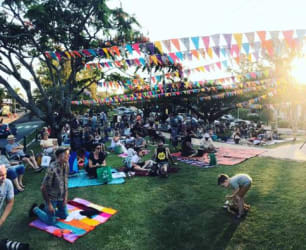The stories of our past are found in the most unusual places. Sometimes in our final resting places. Gravesites can give detail of life as much as death. Their location and environment are as informative as the plaques that may mark them. The earliest of burial places on record are in the heart of the city.
Early Europeans documented the Kombumerri people as being healthy, relaxed and friendly. Nature was bountiful and life was comfortable in paradise. In a land starkly different to their homelands, the first Europeans struggled to adapt. Survival was often dependent on the life skills and good nature of Aboriginal people.
It is therefore surprising that local Indigenous heritage was largely unknown until a gruesome discovery in 1965. New properties in Broadbeach had used infill from nearby wetlands. With erosion, a grisly discovery emerged as human remains, shells and stone artefacts began to surface.
Laila Haglund was the only archeologist in Queensland. At 31 years old and six months pregnant, Ms Haglund was tasked with the excavation.
She found there was little to no knowledge or advocacy of Indigenous heritage in the area. This burial site had ongoing use for thousands of years - even after European settlement, as evidenced with shovel markings in some spots. Somehow this site had been ‘lost’.
From this, Queensland Government requested Ms Haglund draft the first state legislation for Indigenous heritage which was enacted as the Aboriginal Relics Preservation Act 1967.
It took until 1988 for the remains of over 150 people to be reinterred back in Kombumerri Park, Broadbeach.
The earliest Europeans to connect with traditional custodians were timbergetter lads, William Duncan and Neddy Harper. Together as boys in the 1840s, they had become well acquainted with local Indigenous families, language and customs. As men, Duncan was based around the Gilston area and Harper set up his namesake wharf in Surfers Paradise.
Their humble gravesites speak volumes of the lives they led.
William Duncan’s grave is purportedly behind council offices in Burleigh. Over time its markings have disappeared. Nearby in the council gardens sits a seemingly haphazardly-placed gravestone. William's daughter, Sarah, was the first Caucasian child born in the area. Sadly, fate took her life at the tender age of 18 months old. William was working away at the time. His wife Rose buried the infant with the help of local Aboriginal women.
Neddy Harper’s grave sits at a traditional campsite overlooking the Nerang River. Neddy lived comfortably amongst Aboriginal locals, participating in ceremonies and corroborees. Appropriately, Neddy now rests on the high ground of a midden mound in Cascade Gardens, Broadbeach.
Not far away, another midden mound hosts early settler graves. The Gold Coast Historic Museum sits on the site of the area’s earliest sugar mill. Prior to the mill’s construction in the 1860s, Bundall was a place for Kombumerri campsites and ceremonies.
Volunteer, Craig Porter, explains that, “there was a bora ring just behind here. This area was actively used in Aboriginal culture.”
Craig tells me about the dearly departed buried on the midden mound. James Stuart was an engineer for the sugar plantation. Here lies his daughter Emily, who died as a one-year-old. With her, her mother who tragically passed away a mere 10 months later. Sugar mill workers hand-chiselled an inscription on a timber crucifix. Over the last century, memorial plaques of descendants have been added.
In the warm daylight of Spring, there is a sense of peace in the shady reprieve of this littoral rainforest sanctuary. Craig shows me blooming orchids including the endangered Lesser Swamp Orchid (Phaius australis). He points out the rare heritage-listed 300 year-old Tuckeroo and Ribbonwood trees.
“Experts have declared these the largest on the Gold Coast growing in sand”, says Craig.
A fitting resting place for these early pioneers. In a fast-growing city, the gravesites of our earliest ancestors sit hidden in sanctuaries amongst the bustle. Strangely, it is through death that these peaceful places continue to give history life.
Check out the Gold Coast Historic Museum at 8 Elliott St, Surfers Paradise gcmuseum.com.au
IMAGES by Nikki Archer
[gallery ids="52314,52315,52316,52317,52318,52319,52320,52321,52322,52323,52324,52325,52326,52327,52328,52329,52330"]






